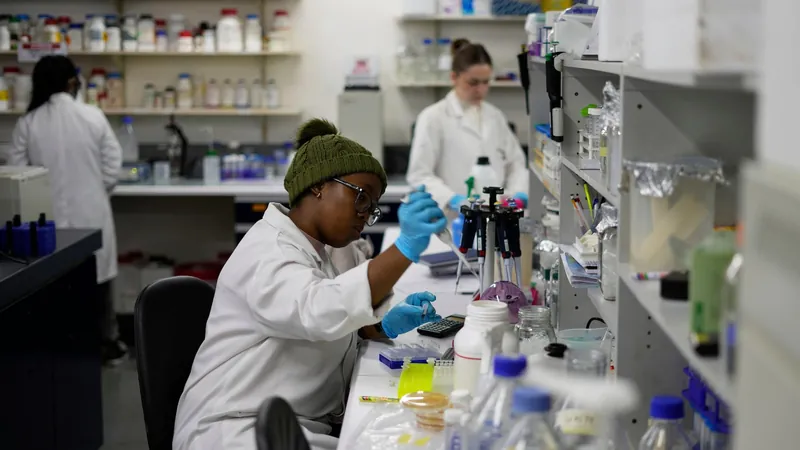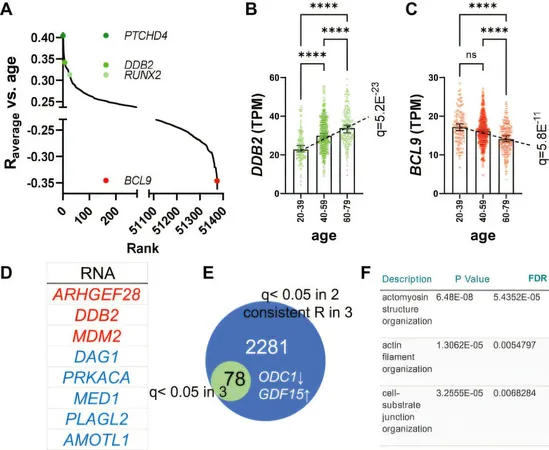
Breakthrough Measurement Sheds Light on the Mysterious Role of Gluons in Atomic Nuclei
2025-05-26
Author: Rajesh
Physicists Dive Deep into Atomic Glue
In a remarkable leap for nuclear physics, a dedicated team of researchers is plunging into the enigmatic world of gluons—those essential particles that glue quarks together to form protons and neutrons, the very core of atoms. This unprecedented measurement, derived from experiments at the U.S. Department of Energy's Thomas Jefferson National Accelerator Facility, is the first of its kind and promises to unveil new insights about gluons.
The Power of Gluons
Gluons play a pivotal role in mediating the strong force, crucially binding quarks within protons and neutrons. While past studies have provided glimpses into gluon distribution within individual protons and neutrons, the behavior of these particles within the complex environment of atomic nuclei has remained largely a mystery. "This breakthrough significantly advances our understanding of the gluon field in protons," stated Axel Schmidt, a George Washington University physicist and principal investigator of the study.
Unlocking the EMC Effect Mystery
For over 40 years, scientists have puzzled over why quarks appear to move more slowly when residing within protons and neutrons in atomic nuclei—a phenomenon known as the EMC effect. Unraveling this enigma requires delving deeper into the world of gluons, yet measuring their distribution poses a challenge since they are neutral and interact solely via the strong force. Lucas Ehinger, a graduate student at the Massachusetts Institute of Technology, emphasized the difficulty of studying these elusive particles and their dynamics within nuclei.
Innovative J/ψ Particle Production
To tackle this challenge, the researchers utilized a clever strategy by measuring a different particle: the J/ψ (J-psi). This particle, consisting of charm quarks, emerges from the interaction between photons and gluons during high-energy collisions. Historically, creating J/ψ particles required an energy threshold of 8.2 GeV, but this team achieved production at lower energies by targeting nuclei like deuterium, helium, and carbon—enhancing the chances of J/ψ generation due to the movement of protons and neutrons within these nuclei.
Charting New Territory in Nuclear Physics
By pioneering techniques to measure J/ψ production below the typical energy barrier, this effort not only sheds light on how gluons operate within grouped protons and neutrons but also sets the stage for future research. As Or Hen, a professor at MIT, described, "We are on the frontiers of understanding nuclear glue, making every measurement a significant contribution to the field."
A Journey of Discovery
This groundbreaking work was not without its challenges. The researchers initially set out with uncertainty about the feasibility of measuring subthreshold J/ψ production, viewing it as a hopeful addition to their experiment. With critical guidance from Jackson Pybus, a graduate student who used innovative theoretical approaches, the team successfully navigated uncharted territory. Their findings hint at a fundamental difference in the behavior of nuclear glue compared to that in solitary protons and neutrons, prompting further investigation.
The Road Ahead: More Experiments on the Horizon
With these promising results in hand, the researchers are eager to embark on larger-scale experiments aimed at refining their understanding of nuclear glue dynamics. Looking ahead, they propose a dedicated study that could profoundly impact the field, as Hen noted, "Imagine what we could achieve with 100 days of focused accelerator time. We’re paving the way for a deeper understanding of the strong nuclear force, which could one day lead to advancements in technology and sustainable energy."
Paving the Way for Future Discoveries
These groundbreaking results may also inform upcoming gluon studies at the anticipated Electron-Ion Collider (EIC), which aims to delve deeper into the world of gluons. As Schmidt pointed out, preemptively addressing this complex problem will be crucial as the EIC gears up for its exploration.







 Brasil (PT)
Brasil (PT)
 Canada (EN)
Canada (EN)
 Chile (ES)
Chile (ES)
 Česko (CS)
Česko (CS)
 대한민국 (KO)
대한민국 (KO)
 España (ES)
España (ES)
 France (FR)
France (FR)
 Hong Kong (EN)
Hong Kong (EN)
 Italia (IT)
Italia (IT)
 日本 (JA)
日本 (JA)
 Magyarország (HU)
Magyarország (HU)
 Norge (NO)
Norge (NO)
 Polska (PL)
Polska (PL)
 Schweiz (DE)
Schweiz (DE)
 Singapore (EN)
Singapore (EN)
 Sverige (SV)
Sverige (SV)
 Suomi (FI)
Suomi (FI)
 Türkiye (TR)
Türkiye (TR)
 الإمارات العربية المتحدة (AR)
الإمارات العربية المتحدة (AR)